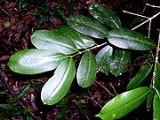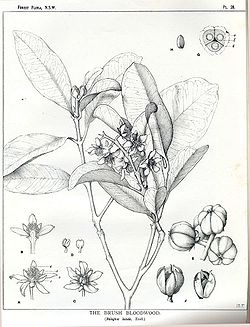
Baloghia inophylla
Encyclopedia
Baloghia inophylla is a rainforest tree of eastern Australia
. It is also known as the Brush Bloodwood, as it occurs in brushes, (a nineteenth century term for rainforest), as well as Bloodwood, as the clear sap is blood red. Other common names include Ivory Birch and Scrub Bloodwood.
to Coen
(13° S) in far north Queensland
. It also occurs in New Caledonia
, Lord Howe Island
and Norfolk Island
. The habitat is most types of rainforest except the cool temperate forests.
Leaves are thick and glossy, 7 to 13 cm long. They are opposite, simple, not toothed, mostly oblong in shape, though at other times elliptical or oval. Identification of this species is made easier when noticing the blunt leaf point and nearly horizontal leaf veins. At the base of the leaf are two swollen glands. Leaf stalks are 8 millimetre (0.31496062992126 in) long, and somewhat channelled on the upper side.
Creamy pink flowers occur on raceme
s in the months of May to January. The five-petaled flower is fragrant, relatively large and attractive. Male and female flowers form on separate racemes.
The fruit matures from February to May, though occasionally at other times of the year. It is a brown roundish capsule 12 to 18 mm long. Inside are three cells, with a single mottled brown seed inside, 8 mm long, although many capsules contain no seeds. Fresh seed germinates reliably, and cuttings strike well.

Australia
Australia , officially the Commonwealth of Australia, is a country in the Southern Hemisphere comprising the mainland of the Australian continent, the island of Tasmania, and numerous smaller islands in the Indian and Pacific Oceans. It is the world's sixth-largest country by total area...
. It is also known as the Brush Bloodwood, as it occurs in brushes, (a nineteenth century term for rainforest), as well as Bloodwood, as the clear sap is blood red. Other common names include Ivory Birch and Scrub Bloodwood.
Distribution
Brush Bloodwood occurs on the eastern coast of Australia from Mount Dromedary (36° S) near Narooma in southern New South WalesNew South Wales
New South Wales is a state of :Australia, located in the east of the country. It is bordered by Queensland, Victoria and South Australia to the north, south and west respectively. To the east, the state is bordered by the Tasman Sea, which forms part of the Pacific Ocean. New South Wales...
to Coen
Coen, Queensland
Coen is a small inland town on the main road heading up the Cape York Peninsula in far northern Queensland, Australia. It is in the Cook Shire Local Government Area. At the 2006 census, Coen had a population of 253....
(13° S) in far north Queensland
Queensland
Queensland is a state of Australia, occupying the north-eastern section of the mainland continent. It is bordered by the Northern Territory, South Australia and New South Wales to the west, south-west and south respectively. To the east, Queensland is bordered by the Coral Sea and Pacific Ocean...
. It also occurs in New Caledonia
New Caledonia
New Caledonia is a special collectivity of France located in the southwest Pacific Ocean, east of Australia and about from Metropolitan France. The archipelago, part of the Melanesia subregion, includes the main island of Grande Terre, the Loyalty Islands, the Belep archipelago, the Isle of...
, Lord Howe Island
Lord Howe Island
Lord Howe Island is an irregularly crescent-shaped volcanic remnant in the Tasman Sea between Australia and New Zealand, directly east of mainland Port Macquarie, and about from Norfolk Island. The island is about 11 km long and between 2.8 km and 0.6 km wide with an area of...
and Norfolk Island
Norfolk Island
Norfolk Island is a small island in the Pacific Ocean located between Australia, New Zealand and New Caledonia. The island is part of the Commonwealth of Australia, but it enjoys a large degree of self-governance...
. The habitat is most types of rainforest except the cool temperate forests.
Description
It is a medium sized tree, reaching 25 metres (82 ft) in height and with a trunk diameter of 50 centimetres (19.7 in). The trunk is usually cylindrical, though some tree bases are fluted. The bark is creamy brown, with reddish and brown markings. The bark also features raised squarish plates of bark.Leaves are thick and glossy, 7 to 13 cm long. They are opposite, simple, not toothed, mostly oblong in shape, though at other times elliptical or oval. Identification of this species is made easier when noticing the blunt leaf point and nearly horizontal leaf veins. At the base of the leaf are two swollen glands. Leaf stalks are 8 millimetre (0.31496062992126 in) long, and somewhat channelled on the upper side.
Creamy pink flowers occur on raceme
Raceme
A raceme is a type of inflorescence that is unbranched and indeterminate and bears pedicellate flowers — flowers having short floral stalks called pedicels — along the axis. In botany, axis means a shoot, in this case one bearing the flowers. In a raceme, the oldest flowers are borne...
s in the months of May to January. The five-petaled flower is fragrant, relatively large and attractive. Male and female flowers form on separate racemes.
The fruit matures from February to May, though occasionally at other times of the year. It is a brown roundish capsule 12 to 18 mm long. Inside are three cells, with a single mottled brown seed inside, 8 mm long, although many capsules contain no seeds. Fresh seed germinates reliably, and cuttings strike well.


